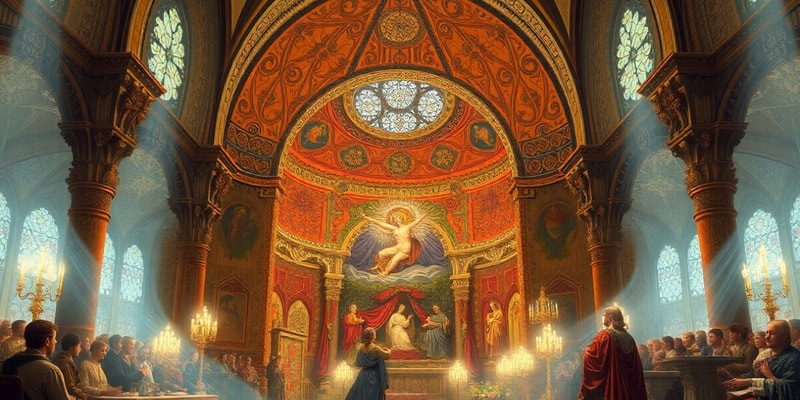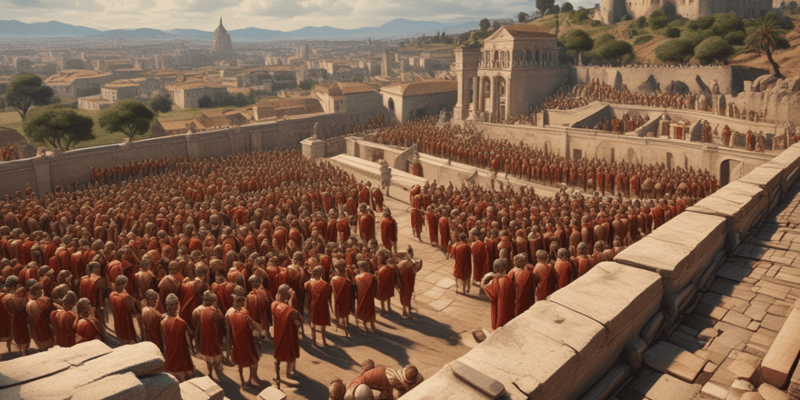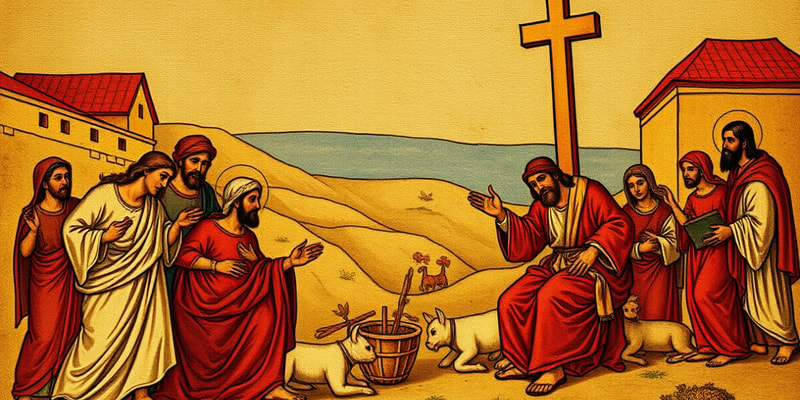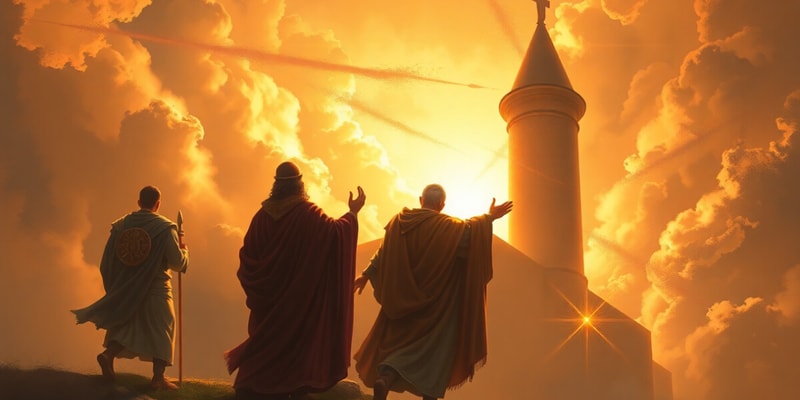Podcast Beta
Questions and Answers
What was the primary religious characteristic of the Roman Empire during its height?
The Roman Empire was primarily polytheistic, lacking a single religious identity.
Describe the process through which Christianity spread throughout the Roman Empire.
Christianity's spread was gradual and referred to as 'Christianisation', influenced by the church hierarchy.
What marked the beginning of the medieval period in the western part of the Roman Empire?
The fragmentation of the empire into Germanic kingdoms, such as the Visigoths, Franks, and Lombards, marked the beginning of the medieval period.
What was the significance of Justinian's rule in the Eastern Roman Empire?
Signup and view all the answers
What was the purpose of the Colosseum in Rome, and what was its seating capacity?
Signup and view all the answers
What were the key factors contributing to the Byzantine recovery of eastern provinces in the 620s?
Signup and view all the answers
In what ways did the unification of Arab tribes influence the expansion of Islam?
Signup and view all the answers
What regions did the Arab armies conquer by the year 642, and why were these conquests significant?
Signup and view all the answers
How did the events in West Asia during the 7th century reflect the conflicts between Rome and Iran?
Signup and view all the answers
Identify two major cities that were crucial to the Islamic expansion as depicted on the map of West Asia.
Signup and view all the answers
What were some key features of the great houses of Rome in the early fifth century?
Signup and view all the answers
How did the monetary system change during the late empire?
Signup and view all the answers
What role did corruption play in the late Roman bureaucracy?
Signup and view all the answers
In what way did Roman law act as a restraint on emperors during Late Antiquity?
Signup and view all the answers
What was the significance of Constantine's establishment of Christianity as the official religion?
Signup and view all the answers
What were the main social groups in the Roman Empire?
Signup and view all the answers
How did the composition of the Senate change by the late Roman Empire?
Signup and view all the answers
What role did the middle class play in the Roman Empire?
Signup and view all the answers
Who were the humiliores, and what categories did they include?
Signup and view all the answers
What was one significant characteristic of the aristocracy in the city of Rome according to Olympiodorus?
Signup and view all the answers
How did the Roman aristocracy maintain their wealth despite being less powerful than military elites?
Signup and view all the answers
Describe two methods employed by Romans to control labor.
Signup and view all the answers
What was a major source of labor for the agricultural sector in the Roman Empire?
Signup and view all the answers
What role did self-employed artisans play in the urban economy of the Roman Empire?
Signup and view all the answers
How did the composition of the labor force affect the social structure in the Roman Empire?
Signup and view all the answers
Study Notes
Religious and Political Transformations
- The Roman Empire lacked a uniform religious identity, with polytheism being prevalent.
- Judaism, while a significant faith, had internal diversity within the empire.
- The spread of Christianity across the empire was gradual, influenced by the church hierarchy.
- The fragmentation of the Western Roman Empire into Germanic kingdoms led to the beginning of the medieval period.
- The Eastern Roman Empire, under Justinian, experienced a peak in prosperity and imperial ambition.
The Colosseum
- Built in 79 CE, the Colosseum was a venue for gladiatorial contests and wild animal displays.
- It had a capacity to hold up to 60,000 spectators.
Themes in World History - Chapter 54
- The Byzantines regained Eastern provinces like Egypt in the 620s after a period of decline.
- The expansion of Islam, originating in Arabia, began in the 7th century.
- Arab armies conquered vast territories of the Eastern Roman and Sasanian Empires by 642.
- The conquests extended into Central Asia and reached as far as Spain.
- The unification of Arabian tribes was a crucial factor in the expansion of Islam.
An Empire Across Three Continents (Map 2: West Asia)
- The map depicts West Asia, focusing on significant cities and regions related to the expansion of Islam.
- Major locations include Constantinople, Antioch, Damascus, Baghdad, Ctesiphon, Medina, and Mecca.
- Key rivers like the Euphrates and Tigris are visible, along with territories like Syria, Palestine, Judea, and Persia (Iran).
Incomes of the Roman Aristocracy, Early Fifth Century
- Large Roman households contained features found in medium-sized cities, including hippodromes, fora, temples, fountains, and baths.
- Many Roman households had an annual income of 4,000 pounds of gold, excluding grain, wine, and other agricultural produce which accounted for approximately a third of their income.
- Second-class households in Rome had incomes ranging from 1,000 to 1,500 pounds of gold per year.
Late Antiquity
- The monetary system in the late empire differed from the silver-based currencies of earlier centuries due to depleted Spanish silver mines and insufficient government stock.
- Constantine introduced a new gold-based monetary system, establishing the solidus as the new standard coin.
- The Roman bureaucracy, particularly higher and middle echelons, were generally affluent, receiving salaries in gold and investing in assets like land.
- Corruption was widespread, especially in the judicial system and administration of military supplies.
- Government intervention through laws and criticism from historians and intellectuals aimed to contain corruption.
- The Roman state was authoritarian, and dissent was met with violence.
- A strong tradition of Roman law emerged in the 4th century, acting as a check on even the most tyrannical emperors.
- Powerful bishops, such as Ambrose, confronted emperors who abused their power.
- The period of Late Antiquity (4th-7th centuries) witnessed substantial cultural, economic, and religious transformations.
- Constantine made Christianity the official religion of the empire in the 4th century.
- The rise of Islam in the 7th century significantly impacted the period.
Social Hierarchies
- Senators (patres): The elite and leading members of Roman society.
- Equestrian class: Individuals holding positions of power and influence.
- Respectable section of the people: Individuals associated with prominent houses.
- Unkempt lower class (plebs sordida): People prone to excessive displays in entertainment venues.
- Slaves: Often held in low regard within the social hierarchy.
- By the late empire, the senate and equestrian class integrated into a larger aristocracy.
- Many families in this expanded aristocracy originated from Africa or the East.
- These aristocrats were wealthy but sometimes less powerful than military elites.
- The middle class comprised individuals in imperial service, bureaucracy, and the army, along with successful merchants and farmers.
- The middle class relied heavily on government employment.
- Lower classes, known as humiliores, included rural laborers, workers in industry and mining, migrant workers, self-employed artisans, wage laborers, and slaves.
- Olympiodorus, an ambassador, reported that Roman aristocracy earned up to 4,000 lbs of gold annually.
The Structure of the Roman State in the Fourth Century CE
- Diocletian implemented significant changes to the Roman state structure in the 3rd century due to overexpansion and various internal challenges.
- He strengthened borders, reorganized provinces, and separated civilian from military functions.
- Diocletian granted increased autonomy to military commanders.
- Constantine further modified the state structure and monetary system.
- He introduced the solidus, a new gold coin that proved more durable than earlier currency forms.
- Constantine established Constantinople as a second capital, strategically located on three sides of the sea, stimulating economic growth and expansion of the governing classes.
Economic Prosperity and Investment
- The 4th century witnessed monetary stability, population growth, and economic prosperity.
- Investments were made in rural infrastructure, including industrial facilities like oil presses, glass factories, and water mills.
- Trade with the East saw a revival during this period.
- Evidence from Egyptian papyri indicates a wealthy society where money was widely used and rural lands generated significant income in gold.
- Taxes in Egypt during Justinian's reign (6th century) reached over 2.5 million solidi per year (approximately 35,000 lbs of gold).
Religious Culture
- Traditional Roman religious practices were polytheistic, encompassing numerous cults, including Roman deities like Jupiter, Juno, Minerva, and Mars, as well as Greek and Eastern divinities.
- These religions were practiced across various temples, shrines, and sanctuaries throughout the empire.
Controlling Workers
- Slavery was a deeply ingrained institution in the ancient world, including the Mediterranean and Near East.
- The Roman economy was not solely reliant on slave labor.
On the Treatment of Slaves
- All slaves in a household were executed following the murder of a city prefect, Lucius Pedanius Secundus, by one of his slaves.
- Tacitus described a riot and resistance against the execution of slaves.
- Slaves were considered an investment, but economic factors like harvests, health risks, and maintenance costs influenced their use in labor.
- Roman upper classes were often harsh towards slaves, while ordinary people showed more empathy.
- With decreasing warfare, the supply of slaves diminished, leading to a shift towards more economically viable alternatives like wage labor.
- Slave labor was not always the most economical option for public projects due to high maintenance costs.
- Slaves had lesser prominence in agriculture in later periods, especially in Eastern provinces.
- Slaves often served as business managers, given capital by their masters to run their own businesses.
Labor Practices in the Roman Empire
- This section focuses on the practice of labor management in the Roman Empire.
- Employers frequently organized workers into “gangs” for easier supervision.
- Ganging was found to be a more effective method for controlling and managing labor.
- Pliny criticized the use of chained slave gangs, considering them to be the worst form of production organization.
- The draconian practices of the Roman Empire are still echoed in modern factories and industrial establishments.
- Alexandria frankincense factories employed strict supervision, requiring workers to wear masks and remove clothes before leaving.
- Debt contracts and forced servitude were used by employers to control workers.
- Second-century texts indicate that individuals surrendered themselves to servitude to repay debt.
- Augustine's letters mention children being sold into servitude by parents to pay off debts.
- Frankincense, a fragrant resin, was tapped from Boswellia trees, with the best quality coming from the Arabian Peninsula.
Studying That Suits You
Use AI to generate personalized quizzes and flashcards to suit your learning preferences.
Description
Explore the key aspects of the Roman Empire's religious landscape and the rise of Christianity. This quiz covers critical events from the empire's height to the onset of the medieval period and the significance of Justinian's rule. Additionally, learn about iconic structures like the Colosseum and their purposes.




